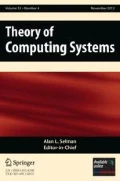Abstract
A distance automaton is a (nondeterministic finite) automaton which is equipped with a nonnegative cost function on its transitions. The distance of a word recognized by such a machine quantifies the expenses associated with the recognition of this word. The distance of a distance automaton is the maximal distance of a word recognized by this machine or is infinite, depending on whether or not a maximum exists. We present distance automata havingn states and distance 2n − 2. As a by-product we obtain regular languages having exponential finite order. Given a finitely ambiguous distance automaton withn states, we show that either its distance is at most 3n − 1, or the growth of the distance in this machine is linear in the input length. The infinite distance problem for these distance automata is NP-hard and solvable in polynomial space. The infinite-order problem for regular languages is PSPACE-complete.
Similar content being viewed by others
References
A. Aho, J. Hopcroft, and J. Ullman,The Design and Analysis of Computer Algorithms, Addison-Wesley, Reading, MA, 1974.
S. Eilenberg,Automata, Languages, and Machines, Volume A, Academic Press, New York, 1974.
M. Garey and D. Johnson,Computers and Intractability, Freeman, San Francisco, CA, 1979.
P. Gohon, Automates de coût borné sur un alphabet à une lettre,RAIRO Inform, théor.,19 (1985), 351–357.
J. Goldstine, C. Kintala, and D. Wotschke, On measuring nondeterminism in regular languages,Inform. and Comput.,86 (1990), 179–194.
J. Goldstine, H. Leung, and D. Wotschke, On the relation between ambiguity and nondeterminism in finite automata,Inform. and Comput.,100 (1992), 261–270.
K. Hashiguchi, A decision procedure for the order of regular events,Theoret. Comput. Sci.,8 (1979), 69–72.
K. Hashiguchi, Limitedness theorem on finite automata with distance functions,J. Comput. System Sci.,24 (1982), 233–244.
K. Hashiguchi, Representation theorems on regular languages,J. Comput. System Sci.,27 (1983), 101–115.
K. Hashiguchi, Algorithms for determining relative star height and star height,Inform. and Comput.,78 (1988), 124–169.
K. Hashiguchi, Improved limitedness theorems on finite automata with distance functions,Theoret. Comput. Sci.,72 (1990), 27–38.
J. Hopcroft and J. Ullman,Introduction to Automata Theory, Languages, and Computation, Addison-Wesiey, Reading, MA, 1979.
T. Ibaraki, Finite automata having cost functions: nondeterministic models,Inform. and Control,37 (1978), 40–69.
C. Kintala and D. Wotschke, Amounts of nondeterminism in finite automata,Acta Inform.,13 (1980), 199–204.
H. Leung, An Algebraic Method for Solving Decision Problems in Finite Automata Theory, Ph.D. Thesis, Pennsylvania State University, 1987.
H. Leung, Limitedness theorem on finite automata with distance functions: an algebraic proof,Theoret. Comput. Sci.,81 (1991), 137–145.
H. Leung, On some decision problems in finite automata,Monoids and Semigroups with Applications, (J. Rhodes, ed.), World Scientific, Singapore, 1991, pp. 509–526.
H. Leung, On finite automata with limited nondeterminism,Proc. Symp. on Mathematical Foundations of Computer Science 1992, Lecture Notes in Computer Science, Vol. 629, Springer-Verlag, Berlin, 1992, pp. 355–363.
A. Salomaa,Jewels of Formal Language Theory, Pitman, London, 1981.
I. Simon, Limited subsets of a free monoid,Proc. 19th Symp. on Foundations of Computer Science, 1978, pp. 143–150.
I. Simon, On Brzozowski's problem: (1 ∪A)m =A*, Seminaire d'Informatique Théorique 1979–1980 (M. Fontet and I. Guessarian, eds.), LITP, Université Paris VI/VII, Paris, 1980, pp. 67–72.
I. Simon, Recognizable sets with multiplicities in the tropical semiring,Proc. Symp. on Mathematical Foundations of Computer Science 1988, Lecture Notes in Computer Science, Vol. 324, Springer-Verlag, Berlin, 1988, pp. 107–120.
I. Simon, On Semigroups of Matrices over the Tropical Semiring, Technical Report RT-MAC-8907, 1ME, Universidade de São Paulo, São Paulo, 1989.
I. Simon, The nondeterministic complexity of a finite automaton,Mots (M. Lothaire, ed.), Hermes, Paris, 1990, pp. 384–400.
A. Weber, Distance automata having large finite distance or finite ambiguity,Proc. Symp. on Mathematical Foundations of Computer Science 1990, Lecture Notes in Computer Science, Vol. 452, Springer-Verlag, Berlin, 1990, pp. 508–515.
A. Weber and H. Seidl, On the degree of ambiguity of finite automata,Theoret. Comput. Sci.,88 (1991), 325–349.
A. Weber and H. Seidl, On finitely generated monoids of matrices with entries in No,RAIRO Inform. théor. Applic.,25 (1991), 19–38.
Author information
Authors and Affiliations
Additional information
A preliminary version of this article appeared in theProceedings of the 15th Symposium on Mathematical Foundations of Computer Science, 1990.
Rights and permissions
About this article
Cite this article
Weber, A. Distance automata having large finite distance or finite ambiguity. Math. Systems Theory 26, 169–185 (1993). https://doi.org/10.1007/BF01202281
Received:
Revised:
Published:
Issue Date:
DOI: https://doi.org/10.1007/BF01202281




